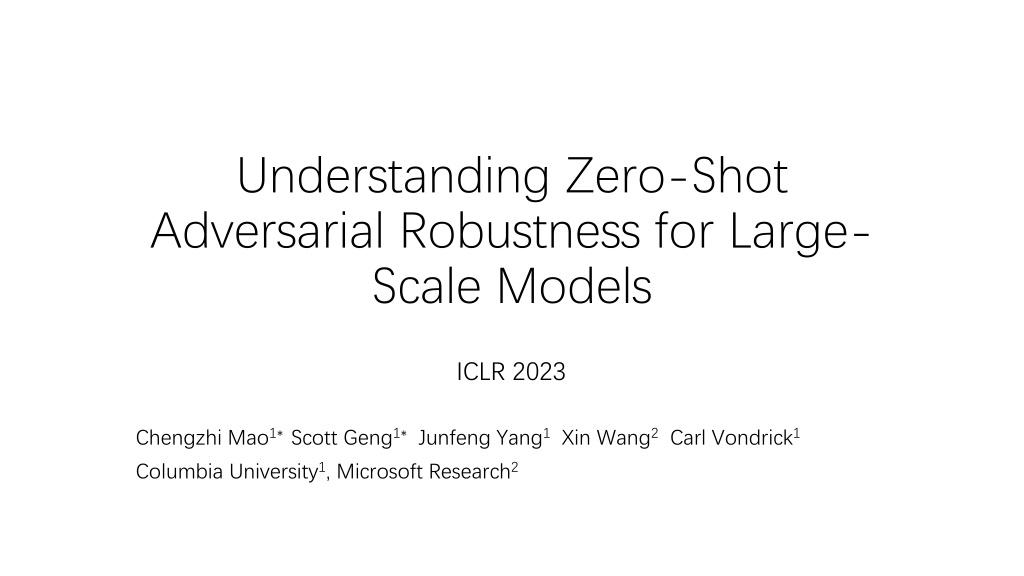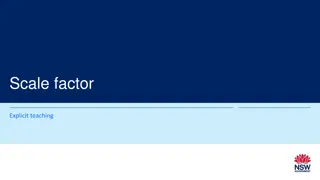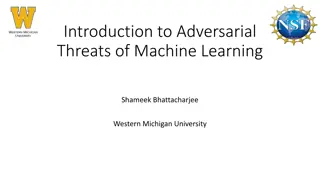Understanding Zero-Shot Adversarial Robustness for Large-Scale Models
Pretrained large-scale vision-language models like CLIP show strong generalization on unseen tasks but are vulnerable to imperceptible adversarial perturbations. This work delves into adapting these models for zero-shot transferability in adversarial robustness, even without specific training on unknown tasks. Key factors include Adaptation Method and Training Objectives, showcasing methods like VPT, FT, Text-guided Contrastive Adversarial Training, and more to enhance model robustness. Experiments compare Contrastive Learning, Text-guided FT, and VPT under various conditions, aiming to balance robustness and accuracy via weight interpolation.
Uploaded on Sep 22, 2024 | 0 Views
Download Presentation

Please find below an Image/Link to download the presentation.
The content on the website is provided AS IS for your information and personal use only. It may not be sold, licensed, or shared on other websites without obtaining consent from the author. Download presentation by click this link. If you encounter any issues during the download, it is possible that the publisher has removed the file from their server.
E N D
Presentation Transcript
Understanding Zero-Shot Adversarial Robustness for Large- Scale Models ICLR 2023 Chengzhi Mao1 Scott Geng1 Junfeng Yang1Xin Wang2Carl Vondrick1 Columbia University1, Microsoft Research2
Problem Setup Can we achieve zero-shot transferability for adversarial robustness, even if the model has never been trained on the unknown tasks? Adaptation Zero-shot Adversarial Robustness two key factors: Adaptation Method Training Objectives
Adaptation Method VPT FT
Training Objective Standard Adversarial Training AT on CLIP linear classification head ?? ?(??(??(??)),?)
Training Objective Text-guided Contrastive Adversarial Training (TeCoA)
Training Objective Contrastive Adversarial Training Loss (CoAdv.) representation Random embedding initialization class: hummingbird
Training Objective Contrastive Adversarial Training over images (ImgCoAdv.) I ? I transformation
Experiments Contrastive Learning v.s. Text guided FT v.s. VPT PGD, 100step, 1/255
Experiments add visual prompt to the input image v.s. append prompt token to the input sequence optimize the same amount of parameters in partial finetuning and VP
Experiments pseudo text label
Experiments Balancing model robustness and clean accuracy via weight interpolation
Abstract(1/2) Pretrained large-scale vision-language models like CLIP have exhibited strong generalization over unseen tasks. Yet imperceptible adversarial perturbations can significantly reduce CLIP s performance on new tasks. In this work, we identify and explore the problem of adapting large-scale models for zero-shot adversarial robustness. We first identify two key , factors during model adaption training losses and adaptation methods that affect the model s zero-shot adversarial robustness.
Abstract(2/2) We then propose a text-guided contrastive adversarial training loss, which aligns the text embeddings and the adversarial visual features with contrastive learning on a small set of prompt training data. We apply this training loss to two adaption methods, model finetuning and visual prompt tuning. We find that visual prompt tuning is more effective in the absence of texts, while finetuning wins in the existence of text guidance. Overall, our approach significantly improves the zero-shot adversarial robustness over CLIP, seeing an average improvement of 31 points over ImageNet and 15 zero-shot datasets. Our code and model is available at github.com/cvlab-columbia/ZSRobust4FoundationModel.
Introduction(1/5) Large-scale models trained on vision and language data also known as - foundation models have emerged as a universal backbone for tackling many recognition problems in computer vision, graphics and robotics. One of the key advantages of foundation models is zero-shot generalization, where the models use just a single textual description to recognize new visual categories with high accuracy. Since those large-scale models are powerful, they will continue to be used in many critical applications, where it is important to make them reliable. However, robustness under adversarial examples remains a challenge, where an imperceptible pattern can be combined with the image to cause recognition failures, where attack on foundation models can consequently corrupt the downstream applications.
Introduction(2/5) Due to the importance of this problem, there is a large literature that investigates adversarial robustness for neural networks. The most common approach for adversarial defense is to learn the model through adversarial training, which - trade-off involves augmenting the training set with mined adversarial examples that fool the image classifier. Adversarial training has been validated to improve robustness on the task that the mined examples come from, but it often comes at a cost of generalization. However, our world is vast and naturally open, and only evaluating adversarial robustness on the learned tasks is limited. Can we achieve zero-shot transferability for adversarial robustness, even if the model has never been trained on the unknown tasks?
Introduction(3/5) In this paper, we study this important yet under-explored problem, zero-shot adversarial robustness of large-scale vision-language models. We start our investigation with the state-of-the-art CLIP model, which has been shown to CLIP be effective in zero-shot recognition tasks. We find that simply adding an imperceptible vector to the image ( 1/255) can subvert CLIP s prediction (see Figure 1a). If we follow the standard adversarial training defense paradigm to finetune CLIP on the ImageNet training set, we observe that the CLIP adapted CLIP has improved adversarial robustness on the ImageNet validation set, but comes at the cost of significantly reduced accuracy on unseen datasets and classes (Figure 1b). Standard adversarial training backfires on CLIP as it fails to retain the model s zero-shot generalization ability.
Introduction(4/5) Adaptation methods and training objectives are the two major factors for adapting a large-scale model. First, besides finetuning the whole model, we seek an alternative adaptation method visual prompt tuning which adapts the inputs instead of the parameters of the model. Visual prompt tuning (VPT) is an emerging light-weight adaptation method that learns a visual prompt which is added to the input image, where we use visual prompt to instruct the model to be robust against adversaries. Second, we find that the standard adversarial training objective ignores the visual-language alignment in CLIP s pretrained representation space, causing the model to lose zero-shot capability. We then propose a text-guided contrastive adversarial training (TeCoA) loss, dubbed as Tekoa (tee kow), which maximizes the similarity of the adversarial visual features and the correct text embeddings with contrastive learning. Since the adapted visual features continue to align well with the text features, the model adapted with TeCoA can maximally retain the original zero-shot generalization of CLIP while enjoying improved adversarial robustness. VPT prompt TeCoA)
Introduction(5/5) We conduct an extensive evaluation on 15 zero-shot image datasets, offering a holistic study of the zero-shot adversarial robustness problem. This is especially important given that large-scale vision models are emerging as infrastructure and are deploying to critical applications. We find that the lightweight VPT is noticeably more effective than model finetuning when textual information is unavailable. When texts are used during adaptation, both VPT and finetuning using our TeCoA loss have drastically improved zero-shot adversarial robustness compared to baselines. Finetuning has higher gains than VPT as more parameters are tuned. Our best performing model with the TeCoA loss can improve adversarial robustness over CLIP by an average of 31% across the datasets. Our method also works on unlabeled images, allowing for better robustness with a large amount of unlabeled data. Our work establish a new and important benchmark, zero-shot adversarial robustness, for future work to evaluate on. We release all models and code. 15 zero-shot 31%























